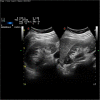Excessive urinary tract dilatation and proteinuria in pregnancy: a common and overlooked association?
- PMID: 23446427
- PMCID: PMC3600000
- DOI: 10.1186/1471-2369-14-52
Excessive urinary tract dilatation and proteinuria in pregnancy: a common and overlooked association?
Abstract
Background: Proteinuria and dilatation of the urinary tract are both relatively common in pregnancy, the latter with a spectrum of symptoms, from none to severe pain and infection. Proteinuria is a rare occurrence in acute obstructive nephropathy; it has been reported in pregnancy, where it may pose a challenging differential diagnosis with pre-eclampsia.The aim of the present study is to report on the incidence of proteinuria (≥ 0.3; ≥ 0.5 g/day) in association with symptomatic-severe urinary tract dilatation in pregnancy.
Methods: Case series.
Setting: Nephrological-Obstetric Unit dedicated to pregnancy and kidney diseases (January 2000-April 2011).
Source: database prospectively updated since the start of the Unit. Retrospective review of clinical charts identified as relevant on the database, by a nephrologist and an obstetrician.
Results: From January 2000 to April 2011, 262 pregnancies were referred. Urinary tract dilatation with or without infection was the main cause of referral in 26 cases (predominantly monolateral in 19 cases): 23 singletons, 1 lost to follow-up, 1 twin and 1 triplet. Patients were referred for urinary tract infection (15 cases) and/or renal pain (10 cases); 6 patients were treated by urologic interventions ("JJ" stenting). Among them, 11 singletons and 1 triple pregnancy developed proteinuria ≥ 0.3 g/day (46.1%). Proteinuria was ≥ 0.5 g/day in 6 singletons (23.1%). Proteinuria resolved after delivery in all cases. No patient developed hypertension; in none was an alternative cause of proteinuria evident. No significant demographic difference was observed in patients with renal dilatation who developed proteinuria versus those who did not. An association with the presence of "JJ" stenting was present (5/6 cases with proteinuria ≥ 0.5 g/day), which may reflect both severer obstruction and a role for vescico-ureteral reflux, induced by the stent.
Conclusions: Symptomatic urinary tract dilatation may be associated with proteinuria in pregnancy. This association should be kept in mind in the differential diagnosis with other causes of proteinuria in pregnancy, including pre-eclampsia.
Figures

Similar articles
-
Outcome of 116 moderate renal pelvis dilatations at prenatal ultrasonography.Fetal Diagn Ther. 1998 Mar-Apr;13(2):79-81. doi: 10.1159/000020810. Fetal Diagn Ther. 1998. PMID: 9650651
-
Acute maternal obstructive renal failure in a twin gestation despite normal physiological pregnancy-induced urinary tract dilation.Am J Perinatol. 1994 May;11(3):242-4. doi: 10.1055/s-2008-1040755. Am J Perinatol. 1994. PMID: 8048994
-
Pregnancies in women with childhood vesicoureteral reflux.Acta Obstet Gynecol Scand. 2015 Aug;94(8):847-51. doi: 10.1111/aogs.12664. Epub 2015 May 11. Acta Obstet Gynecol Scand. 2015. PMID: 25912311
-
Urologic problems of pregnancy.Obstet Gynecol Surv. 1984 Oct;39(10):605-15. doi: 10.1097/00006254-198410000-00001. Obstet Gynecol Surv. 1984. PMID: 6387552 Review. No abstract available.
-
Investigation of the dilated urinary tract.Pediatr Nephrol. 1988 Jan;2(1):43-7. doi: 10.1007/BF00870379. Pediatr Nephrol. 1988. PMID: 3153000 Review.
Cited by
-
A best practice position statement on pregnancy in chronic kidney disease: the Italian Study Group on Kidney and Pregnancy.J Nephrol. 2016 Jun;29(3):277-303. doi: 10.1007/s40620-016-0285-6. Epub 2016 Mar 17. J Nephrol. 2016. PMID: 26988973 Free PMC article. Review.
-
A simple pregnancy-related kidney disease screening method: random proteinuria testing.Korean J Intern Med. 2017 Nov;32(6):996-997. doi: 10.3904/kjim.2017.341. Epub 2017 Oct 27. Korean J Intern Med. 2017. PMID: 29096429 Free PMC article. No abstract available.
-
Preeclampsia from a renal point of view: Insides into disease models, biomarkers and therapy.World J Nephrol. 2014 Nov 6;3(4):169-81. doi: 10.5527/wjn.v3.i4.169. World J Nephrol. 2014. PMID: 25374810 Free PMC article. Review.
References
MeSH terms
LinkOut - more resources
Full Text Sources
Other Literature Sources
Medical
Miscellaneous

